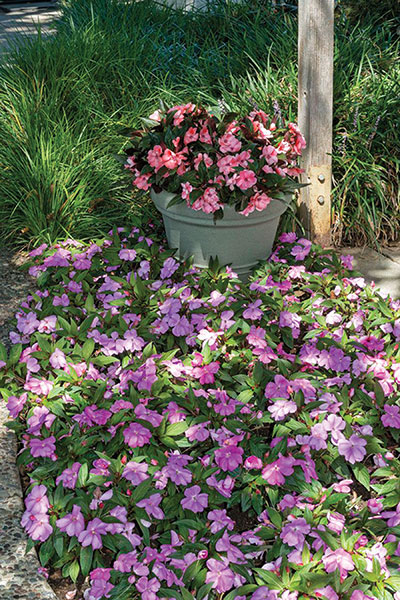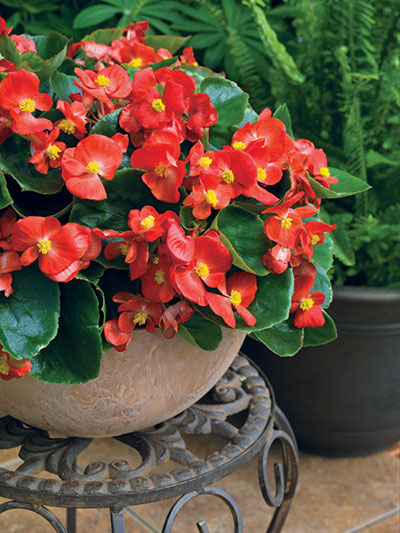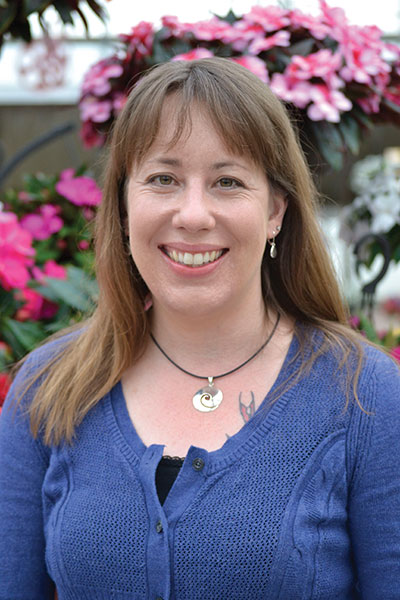
Impatiens walleriana has become the workhorse in shady landscape areas because of its consistent performance and reliable, season-long flowering.
Impatiens walleriana has become the workhorse in shady landscape areas because of its consistent performance and reliable, season-long flowering. With the progression of Impatiens Downy Mildew (IDM) throughout North America in the last few years, growers and landscapers alike have had to re-evaluate what other plant species can provide the same outstanding performance in the garden.
 |
|
| ‘Florific’ New Guinea impatiens in the landscape. PHOTOS COURTESY SYNGENTA FLOWERS Advertisement
|
Reports of devastating IDM infections were first documented in Europe in 2003, and then confirmed in the U.S. in 2011 in both greenhouses and landscapes. Recently, the disease has been identified in landscapes throughout Canada as well.
The causal agent of Impatiens Downy Mildew is Plasmopara obducens, a water mould, or oomycete. This particular strain of downy mildew only affects Impatiens walleriana (common garden impatiens) and Impatiens balsamina (native impatiens species found in North America).
Symptoms of IDM start as a general yellowing, lack of vigour and mild inconspicuous mottling of the leaves. As the disease progresses, the plant will start to wilt, with downward curling or distorted leaves, drop leaves and eventually collapse.
The most distinct sign of IDM is the fuzzy white to light-gray spores that form on the underside of the leaves. IDM sporulates quickly during cool, humid conditions.
However, infected plants can appear “symptom-free” under warmer, dry conditions. Stressed, nutrient-deficient plants tend to show the disease sooner than well-fertilized, healthy impatiens.
IDM is difficult to control once the disease is present. Growers must focus on developing preventive plant protection programs to help limit the infestation of this disease. Once the disease has been identified in the greenhouse or landscape, curative fungicide applications are extremely limited in their effectiveness. Cultural practices that include strict sanitation, scouting and preventive fungicide applications are the best way to limit the risk of spreading IDM.
WHAT ARE THE ALTERNATIVES
With the limitation of fungicides for landscape application, areas that have had IDM present should look at alternative plantings to Impatiens. When considering appropriate substitutions there are several factors that should be considered.
 |
|
| Bada Bingtm and Bada Boomtm begonia series are great for high-density pack production. |
Garden or landscape use – what kind of exposure will this plant need to perform under (shade, part-shade, full sun) and how will it be used (bedding, containers, etc.)
Geography and climate – providing plant species that perform well in the intended area
Seasonality – appropriate for the time of year
Grower considerations – crop time, special cultural requirements and profitablity!
FlorificTM New Guinea impatiens (F1 Impatiens hawkeri)TM: This new series of New Guinea impatiens from seed is a great choice for an alternative to Impatiens walleriana for many reasons. Impatiens hawkeri (or New Guinea Impatiens) are not susceptible to IDM, so there is no risk of infection with these types of impatiens. Florific New Guinea impatiens has been bred for a compact habit that works well in large packs and quarts for high density greenhouse production.
For the grower, Florific does have a longer crop time than impatiens walleriana. Typically, it takes 12 to 14 weeks from sow to finish at an average daily temperauture of 23 C (73 F). This series also prefers a warmer environment for growing, especially in the plug stage.
Maintaining 24-26 C (74-76 F) during plug production is recommended for optium yield, then reducing temperatures is possible for finishing the crop.
Like all New Guinea impatiens, Florific is sensitive to high media salts, so EC should be monitored to keep less than 1.5 mS/cm to avoid stunting and leaf tip burn.
Florific performs well in shade- to part-shade exposures, so it should be a natural fit in areas where impatiens walleriana worked well in the past. The range of colours is expanding in this series, with Lavender, Red, Sweet Orange, Violet, White and Florific mix available.
Fibrous Begonias (F1 begonias semperflorens): Fibrous begonias can be a great substitution for shade to part-shade locations, especially with the wide range of series available on the market. Bada Bingtm and Bada Boomtm begonia series are great for high density pack production, while Eurekatm and Volumiatm begonias both provide vigorous and reliable landscape performance.
Fibrous begonias will have a longer production time than impatiens walleriana, usually seven to eight weeks in the plug stage and five to seven weeks in finished production depending on pot size and series.
Begonias are also a warm temperature crop, so it is critical to plan on having a warm location available in the greenhouse to produce this crop. Providing supplemental lighting in the early spring will help speed root and shoot formation and shorten crop time.
Out in the landscape, fibrous begonias are known for their consistent flower power in shady conditions. They do prefer moist conditions for the best landscape performance.
SaratogaTM Nicotiana (F1 Nicotiana × alata): Often an overlooked plant for shade to part-shade areas, SaratogaTM nicotiana can be a good alternative to impatiens. With it’s upright habit and eye-catching flowers, Saratoga nicotiana performs well as a border plant, in mass plantings or in containers.
Saratogo nicotiana is an excellent substitution in the greenhouse because of its similar crop time and temperarture requirements to impatiens. Plan on nine to 11 weeks of crop time in packs or small pots.
DuchessTM Torenia (F1 Torenia fournieri): A versatile bedding plant that works great in both shade and sunny conditions makes Duchesstm torenia an easy substitution for impatiens. Duchess torenia is bred to be a compact, mounding plant that is ideal for garden beds or containers.
With similar crop time and temperature requirements, Duchess torenia can easily fill in production space that was previously used by impatiens. This series is perfect for small pack and pot, high-density production.
In the landscape, it provides low maintenance, self-cleaning flowers and those hard-to-find blue shades of colour!
OTHER NOTABLES
Pansy (F1 Viola × wittrockiana)and Violas (F1 Viola cornuta) are great season extenders in spring and fall. Used in shady locations, series like DeltaTM pansies and PennyTM violas can have nice colour impact well into the summer seasons or work great in mild winter climates. Consider the new trailing series of pansy WonderFallTM for large hanging baskets and containers, as well as for its fantastic spreading habit in the landscape.
Cora® vinca (F1Catharanthus roseus) may not be the first series to come to mind when thinking of impatiens substitutions, but with the similar habit and colour range it can work well in part-shade exposure in high light climates.
The LaserTM cyclamen series is an intermediate type of cyclamen that works great in landscape applications. Used in cooler climates, it has outstanding flowering and landscape performance as well as a great range of available colours.
THINK OUTSIDE THE BOX
Within the horticulture industry, we should continue to work towards providing healthy, disease-free impatiens to the market. Take the time to understand and implement best practices to help impatiens thrive in the landscape.
In areas that have been hit hard with Impatiens Downy Mildew in the landscape, be sure to consider all the factors that will influence the success of alternative plants to Impatiens walleriana. Be creative and experiment with those non-traditional alternatives!
©2014 Syngenta. Always read and follow label directions. The trademarks displayed or otherwise used herein are trademarks of a Syngenta Group Company or third parties.
 |
|
Amy Briggs-Macha is the Technical Lead for Syngenta Flowers Customer Solutions. She joined Syngenta Flowers, Home and Garden, in 2013 after working for 13 years as the production manager for Tagawa Greenhouses in Denver, Colorado. She graduated from Colorado State University with a degree in horticulture. She was a speaker at this year’s Greenhouse Canada Grower Day in June.
Print this page